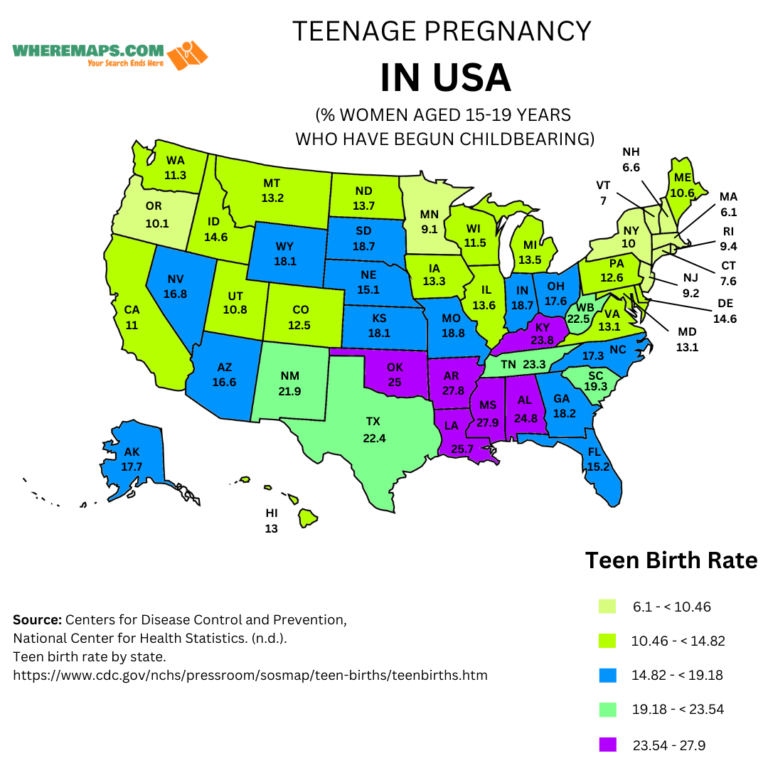Intro
Teenage pregnancy has been a persistent social issue in the United States for many years. According to data from the Centers for Disease Control and Prevention (CDC), there were 15.2 births per 1,000 females aged 15-19 in 2019. While this rate has declined since the 1990s.
TEENAGE PREGNANCY IN USA TABLE LIST STATE WISE
| STATE ABBR. | STATE NAME | RATE |
| AL | Alabama | 24.8 |
| AK | Alaska | 17.7 |
| AZ | Arizona | 16.6 |
| AR | Arkansas | 27.8 |
| CA | California | 11 |
| CO | Colorado | 12.5 |
| CT | Connecticut | 7.6 |
| DE | Delaware | 14.6 |
| FL | Florida | 15.2 |
| GA | Georgia | 18.2 |
| HI | Hawaii | 13 |
| ID | Idaho | 14.6 |
| IL | Illinois | 13.6 |
| IN | Indiana | 18.7 |
| IA | Iowa | 13.3 |
| KS | Kansas | 18.1 |
| KY | Kentucky | 23.8 |
| LA | Louisiana | 25.7 |
| ME | Maine | 10.6 |
| MD | Maryland | 13.1 |
| MA | Massachusetts | 6.1 |
| MI | Michigan | 13.5 |
| MN | Minnesota | 9.1 |
| MS | Mississippi | 27.9 |
| MO | Missouri | 18.8 |
| MT | Montana | 13.2 |
| NE | Nebraska | 15.1 |
| NV | Nevada | 16.8 |
| NH | New Hampshire | 6.6 |
| NJ | New Jersey | 9.2 |
| NM | New Mexico | 21.9 |
| NY | New York | 10 |
| NC | North Carolina | 17.3 |
| ND | North Dakota | 13.7 |
| OH | Ohio | 17.6 |
| OK | Oklahoma | 25 |
| OR | Oregon | 10.1 |
| PA | Pennsylvania | 12.6 |
| RI | Rhode Island | 9.4 |
| SC | South Carolina | 19.3 |
| SD | South Dakota | 18.7 |
| TN | Tennessee | 23.3 |
| TX | Texas | 22.4 |
| UT | Utah | 10.8 |
| VT | Vermont | 7 |
| VA | Virginia | 13.1 |
| WA | Washington | 11.3 |
| WV | West Virginia | 22.5 |
| WI | Wisconsin | 11.5 |
| WY | Wyoming | 18.1 |
Number of births per 1,000 females aged 15–19. This data is from the year 2020. Latest info will be updated soon.
Source: CDC/National Center for Health Statistics
Reason
Research suggests that factors such as poverty, lack of access to comprehensive sex education and contraception, and cultural attitudes toward sex and pregnancy can all contribute to the problem.
One major factor is the lack of access to comprehensive sex education in schools. While many states require some form of sex education, the content and quality of these programs can vary widely. Some states still teach abstinence-only sex education, which is ineffective at preventing unintended pregnancies.
Another factor is poverty. Teenagers from low-income families are more likely to become pregnant, as they may lack access to effective contraception or may not have the resources to raise a child. Additionally, cultural attitudes towards sex and pregnancy can play a role, with some communities viewing teenage pregnancy as a rite of passage or a sign of maturity.
Prevention
Efforts to address teenage pregnancy must focus on providing young people with the knowledge and resources they need to make informed decisions about their sexual health. This includes comprehensive sex education that covers topics such as contraception, healthy relationships, and consent. It also includes ensuring that young people have access to affordable and effective contraception, regardless of their income level or geographic location.
Community-based programs can also play an important role in reducing teenage pregnancy rates. These programs can provide young people with a safe and supportive environment where they can learn about sexual health and receive counseling and support.

